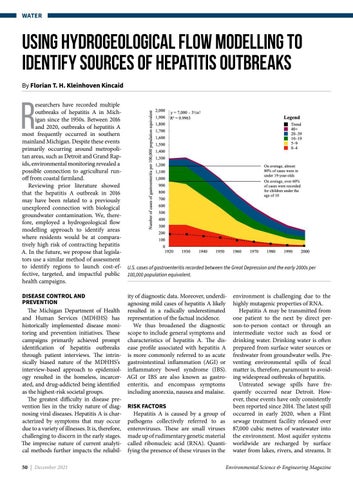WATER
Using hydrogeological flow modelling to identify sources of hepatitis outbreaks By Florian T. H. Kleinhoven Kincaid
R
esearchers have recorded multiple outbreaks of hepatitis A in Michigan since the 1950s. Between 2016 and 2020, outbreaks of hepatitis A most frequently occurred in southern mainland Michigan. Despite these events primarily occurring around metropolitan areas, such as Detroit and Grand Rapids, environmental monitoring revealed a possible connection to agricultural runoff from coastal farmland. Reviewing prior literature showed that the hepatitis A outbreak in 2016 may have been related to a previously unexplored connection with biological groundwater contamination. We, therefore, employed a hydrogeological flow modelling approach to identify areas where residents would be at comparatively high risk of contracting hepatitis A. In the future, we propose that legislators use a similar method of assessment to identify regions to launch cost-ef- U.S. cases of gastroenteritis recorded between the Great Depression and the early 2000s per fective, targeted, and impactful public 100,000 population equivalent. health campaigns. DISEASE CONTROL AND PREVENTION The Michigan Department of Health and Human Services (MDHHS) has historically implemented disease monitoring and prevention initiatives. These campaigns primarily achieved prompt identification of hepatitis outbreaks through patient interviews. The intrinsically biased nature of the MDHHS’s interview-based approach to epidemiology resulted in the homeless, incarcerated, and drug-addicted being identified as the highest-risk societal groups. The greatest difficulty in disease prevention lies in the tricky nature of diagnosing viral diseases. Hepatitis A is characterized by symptoms that may occur due to a variety of illnesses. It is, therefore, challenging to discern in the early stages. The imprecise nature of current analytical methods further impacts the reliabil50 | December 2021
ity of diagnostic data. Moreover, underdiagnosing mild cases of hepatitis A likely resulted in a radically underestimated representation of the factual incidence. We thus broadened the diagnostic scope to include general symptoms and characteristics of hepatitis A. The disease profile associated with hepatitis A is more commonly referred to as acute gastrointestinal inflammation (AGI) or inflammatory bowel syndrome (IBS). AGI or IBS are also known as gastroenteritis, and encompass symptoms including anorexia, nausea and malaise.
environment is challenging due to the highly mutagenic properties of RNA. Hepatitis A may be transmitted from one patient to the next by direct person-to-person contact or through an intermediate vector such as food or drinking water. Drinking water is often prepared from surface water sources or freshwater from groundwater wells. Preventing environmental spills of fecal matter is, therefore, paramount to avoiding widespread outbreaks of hepatitis. Untreated sewage spills have frequently occurred near Detroit. However, these events have only consistently RISK FACTORS been reported since 2014. The latest spill Hepatitis A is caused by a group of occurred in early 2020, when a Flint pathogens collectively referred to as sewage treatment facility released over enteroviruses. These are small viruses 87,000 cubic metres of wastewater into made up of rudimentary genetic material the environment. Most aquifer systems called ribonucleic acid (RNA). Quanti- worldwide are recharged by surface fying the presence of these viruses in the water from lakes, rivers, and streams. It Environmental Science & Engineering Magazine


























